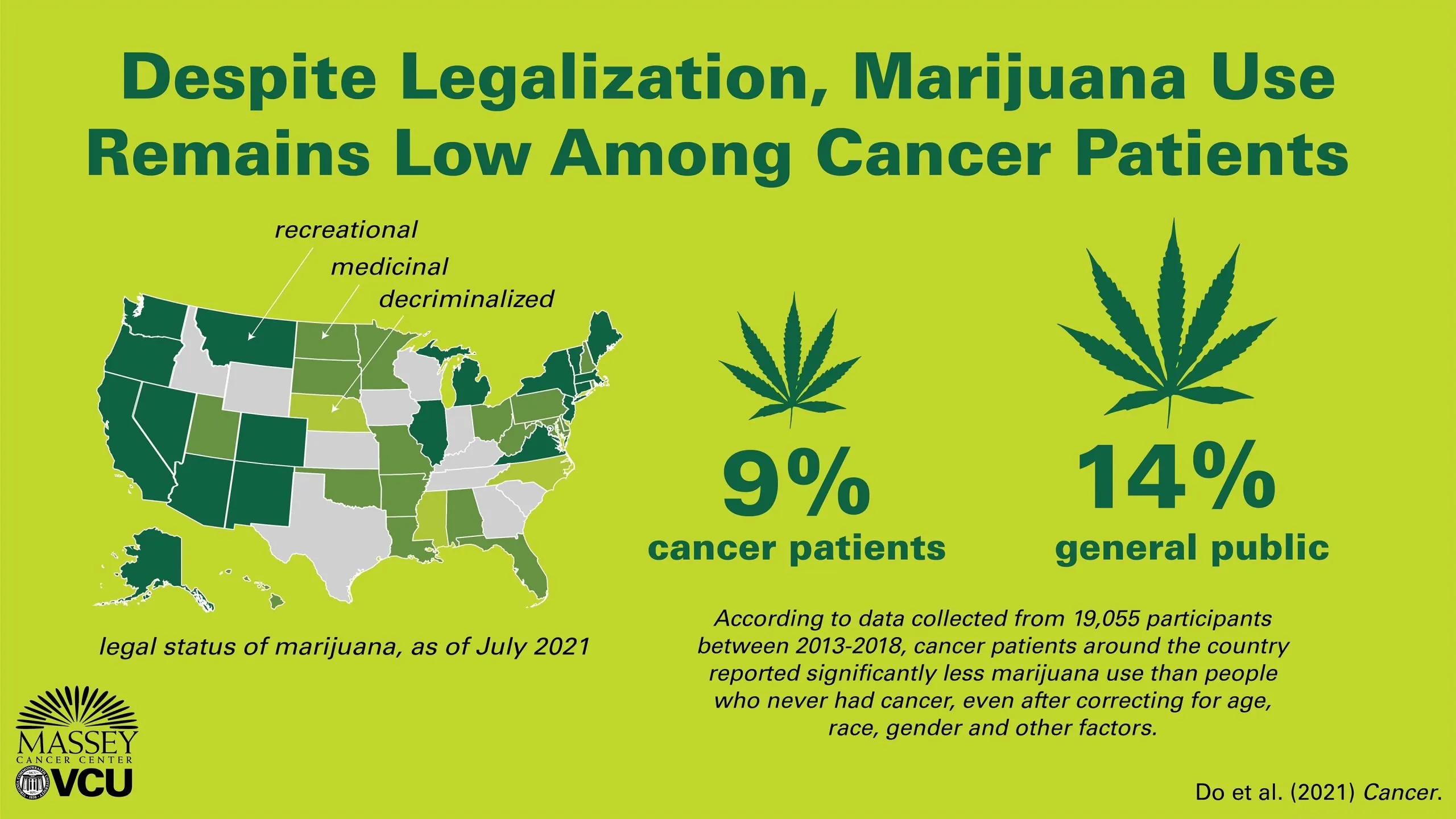Introduction
The use of medical cannabis has been gaining attention as a potential treatment for various health conditions, and cancer is one of the most closely watched areas. As more patients and doctors explore alternative ways to manage the challenges of cancer treatment, cannabis has become a topic of interest for its potential benefits in managing symptoms and possibly even fighting cancer itself. But what does the research really say? Is cannabis a game-changer for cancer treatment, or is it just a supplement to traditional methods?
Cancer treatments like chemotherapy and radiation often come with intense side effects, such as pain, nausea, and loss of appetite. Many patients have turned to medical cannabis in hopes of finding relief where conventional medications may fall short. Early studies suggest that cannabis may help with managing some of these symptoms, especially nausea and chronic pain, making life a little easier for those undergoing treatment. But beyond symptom management, some research has looked at whether cannabis can actually slow down cancer cell growth or even kill cancer cells. This idea, while promising, is still largely in the experimental phase, and scientists are far from confirming whether cannabis could one day be used as a direct treatment for cancer.
At the heart of this discussion are the active compounds in cannabis, known as cannabinoids. Two of the most well-known cannabinoids, THC and CBD, have been studied for their effects on the body’s systems. While THC is responsible for the “high” that many associate with cannabis, it also has been shown to help with pain relief and stimulating appetite. On the other hand, CBD is known for its anti-inflammatory and calming effects without causing a high. Both of these compounds are being investigated for their potential to interact with cancer cells, although the research is still in its early stages.
There’s no denying that interest in medical cannabis for cancer is growing, but the science behind it remains complex. Much of the research has been conducted in labs or on animals, and while some findings are hopeful, human trials are still limited. This means it could be years before we fully understand how cannabis might work alongside or in place of traditional cancer treatments. For now, cannabis seems to offer a complementary approach, helping to improve the quality of life for patients dealing with the difficult side effects of cancer therapy.

The Basics of Medical Cannabis
Medical cannabis is a term used to describe the use of the cannabis plant, or its active compounds, to treat symptoms of various health conditions. When it comes to cancer, there’s been a lot of buzz around whether cannabis can not only help with symptom relief but also potentially impact the disease itself. But before diving into how it might affect cancer, it’s important to understand the basics of how medical cannabis works and what makes it different from recreational use.
Cannabinoids: THC, CBD, and Their Differences
The magic of cannabis comes from its active compounds called cannabinoids. The two most famous ones are THC (tetrahydrocannabinol) and CBD (cannabidiol). While they both come from the same plant, their effects on the body are very different.
THC is the compound responsible for the psychoactive effects—the “high” people experience when using cannabis recreationally. But beyond that, THC is also known for its ability to help with pain, nausea, and appetite stimulation, which is why it’s often used by cancer patients.
CBD, on the other hand, doesn’t cause a high but has shown promise in reducing inflammation, easing anxiety, and even helping with pain relief without the mind-altering effects.
The Endocannabinoid System: How It Works
What makes these cannabinoids work in the body is a complex system called the endocannabinoid system. This is a network of receptors found throughout the body, particularly in the brain and immune system, that help regulate various functions like mood, sleep, and pain.
When cannabinoids from cannabis interact with this system, they can help restore balance, which is why cannabis is being looked at for so many different health conditions, including cancer.
Cannabis and Its Role in Cancer Care
When it comes to cancer, researchers are particularly interested in how cannabinoids like THC and CBD may affect cancer cells and the body’s response to the disease. Although there’s still a lot to learn, early research suggests that cannabis might have a role to play in symptom management as well as in potentially targeting cancer cells themselves.
However, the idea that cannabis can directly treat cancer is still up for debate, and most of the current research is focused on how it can be used to improve quality of life for patients undergoing traditional cancer treatments.
Potential Anti-Cancer Properties of Cannabis
There’s been growing interest in whether cannabis could actually play a direct role in treating cancer, beyond just helping with symptoms. While this research is still in its early stages, some studies have shown that cannabinoids like THC and CBD may have the potential to affect cancer cells in various ways. This section looks at the science behind cannabis’s possible anti-cancer properties and what researchers have discovered so far.
Cannabis and Tumor Growth: Early Lab Studies
In the lab, researchers have been investigating how cannabis interacts with cancer cells, primarily in test tubes and animal models. Some early studies suggest that cannabinoids like THC and CBD could slow the growth of tumors. These lab-based studies have shown that cannabinoids might help inhibit cancer cell proliferation, which is the process where cancer cells rapidly multiply.
The findings from these lab studies are promising, but it’s important to note that these results don’t automatically translate to humans. A lot more research is needed before scientists can confirm whether these effects would be the same in human cancer patients.

How Cannabis Might Interfere with Cancer Cell Pathways
One of the key areas of research focuses on how cannabinoids might interfere with the pathways that cancer cells use to grow and spread. For example, cannabis could potentially disrupt a process called angiogenesis, which is when tumors create new blood vessels to support their growth. By blocking these pathways, cannabis might help starve the tumor of the nutrients it needs.
This line of research is still in its infancy, but scientists are excited about the possibilities. Cannabinoids might be able to target specific pathways used by different types of cancer cells, offering new avenues for treatment. However, these theories still need to be rigorously tested in clinical trials.
Human Clinical Trials: Progress and Setbacks
So far, most of the research into cannabis and cancer has been conducted on animals or in labs. However, there have been some small-scale clinical trials involving humans. These trials have primarily focused on understanding whether cannabis can be safely used alongside traditional cancer treatments like chemotherapy and radiation.
Some studies have looked at cannabis’s impact on cancer cell growth in humans, but the results have been mixed, and the sample sizes were often too small to draw definitive conclusions. The main challenge is the lack of large-scale human clinical trials, which are necessary to prove whether cannabis can directly fight cancer in humans.
Additionally, legal and regulatory hurdles make it difficult for researchers to conduct these trials in many parts of the world.
Managing Cancer Symptoms with Medical Cannabis
One of the most well-established uses of medical cannabis is to help manage the often debilitating symptoms that come with cancer and its treatments. For many patients, chemotherapy, radiation, and other treatments can cause a range of side effects that severely impact their quality of life. Medical cannabis has shown promise in offering relief from several of these symptoms, making it a popular choice among cancer patients.
Nausea and Vomiting: Easing Chemotherapy Side Effects
Chemotherapy is notorious for causing severe nausea and vomiting, which can be hard to control with standard medications. Many cancer patients turn to medical cannabis to help with this problem, and studies have supported its effectiveness. In fact, cannabis has been used for years to manage nausea related to chemotherapy.
THC, in particular, has been shown to reduce both nausea and vomiting, which is why it’s often recommended to patients undergoing aggressive treatments. Cannabis-based medications like dronabinol, which contains synthetic THC, are even approved in some countries for treating chemotherapy-induced nausea and vomiting. While it’s not a perfect solution for everyone, many patients report significant improvements.
Pain Relief: A Natural Option for Cancer Patients
Chronic pain is another common issue for cancer patients, whether it’s caused by the cancer itself or the treatments. Medical cannabis is increasingly being used as a natural alternative to opioids and other strong painkillers, which can come with unwanted side effects or the risk of addiction.
Both THC and CBD have pain-relieving properties, though they work in different ways. THC can alter the brain’s perception of pain, providing relief to patients experiencing moderate to severe discomfort. CBD, on the other hand, has been shown to reduce inflammation, which can also help with pain. Together, these cannabinoids offer a more holistic approach to pain management.
Appetite Stimulation: Combating Weight Loss and Malnutrition
One of the most frustrating side effects of cancer treatment is a loss of appetite, which can lead to unhealthy weight loss and malnutrition. Medical cannabis, particularly strains high in THC, has long been known for its ability to stimulate appetite. Cancer patients who struggle to eat due to nausea or a lack of hunger often find relief with cannabis, which can help them regain their appetite and maintain their strength during treatment.
This effect is commonly referred to as “the munchies,” but for cancer patients, it’s far more than just a side effect—it’s a crucial benefit that can make a real difference in their overall health and recovery. Maintaining a healthy diet during cancer treatment is vital, and medical cannabis can be a helpful tool for those who need a little extra help keeping up their appetite.

Anxiety and Depression: Improving Mental Health
Cancer takes a heavy toll on mental health as well. Many patients experience anxiety, depression, and overall emotional distress during their cancer journey. Medical cannabis, particularly CBD, has been studied for its calming and anti-anxiety effects. While it’s not a cure for mental health conditions, cannabis can help patients relax, sleep better, and manage the emotional rollercoaster that often comes with a cancer diagnosis.
Some cancer patients prefer CBD over THC for mental health management because it doesn’t cause the high associated with THC, making it easier to use throughout the day without impairing mental clarity. The calming effects of CBD can help ease anxiety, improve mood, and even combat insomnia, which is common among cancer patients.
The Safety and Risks of Using Medical Cannabis for Cancer
While medical cannabis is often viewed as a natural remedy, it’s important to understand that, like any treatment, it comes with its own set of risks and potential side effects. As more cancer patients turn to cannabis for symptom management or even as part of their treatment plan, understanding the safety concerns is crucial. This section explores the known risks, possible interactions with other medications, and the importance of consulting healthcare providers before using cannabis.
Common Side Effects: What Patients Should Expect
Even though cannabis is generally considered safe, it’s not without side effects. The most commonly reported side effects of using cannabis, especially those high in THC, include dizziness, dry mouth, and increased heart rate. Some patients may also experience drowsiness or fatigue, which can be problematic for those who need to stay alert during the day.
For cancer patients, these side effects can sometimes be an added burden, especially when dealing with other treatment-related symptoms. It’s important to note that the intensity of these side effects can vary depending on the strain of cannabis, the method of consumption, and the individual’s tolerance levels. Patients new to cannabis may experience more pronounced effects and should start with a low dose to avoid overwhelming sensations.
Mental Health Concerns: Anxiety, Paranoia, and Cognitive Effects
While cannabis, especially CBD, can help with anxiety and depression in some patients, THC can have the opposite effect in certain people. High doses of THC have been known to cause feelings of anxiety, paranoia, or even panic attacks, particularly in individuals who are sensitive to its psychoactive effects. Cancer patients who already struggle with anxiety or depression should be cautious when using cannabis and may want to avoid strains with high THC content.
Additionally, long-term use of cannabis, particularly in high doses, has been linked to cognitive issues such as memory problems and difficulty concentrating. For cancer patients already dealing with “chemo brain”—a common term for the cognitive fog associated with chemotherapy—cannabis could potentially exacerbate these issues.
Drug Interactions: How Cannabis May Affect Other Medications
One of the biggest safety concerns when it comes to using medical cannabis is how it interacts with other medications. Cancer patients are often taking a range of drugs, from chemotherapy agents to pain relievers and anti-nausea medications. Cannabis, especially when consumed in high amounts, has the potential to interact with these drugs, either by increasing their effects or reducing their effectiveness.
For example, cannabis may enhance the sedative effects of medications used to treat anxiety or sleep disorders, leading to excessive drowsiness. On the other hand, it could potentially reduce the effectiveness of certain chemotherapy drugs, which could impact cancer treatment outcomes. That’s why it’s absolutely essential for patients to consult with their doctors before adding cannabis to their treatment regimen.
Legal Considerations: Varying Laws and Access Issues
Another factor to consider is the legal status of cannabis. While medical cannabis is legal in many states and countries, the laws around its use can vary widely. Some places may have strict regulations around who can access medical cannabis, how much can be purchased, and which forms are allowed. Cancer patients who are considering using cannabis as part of their treatment should familiarize themselves with the legal landscape in their area to ensure they’re in compliance with local laws.
In some cases, patients may need a prescription or medical card to legally obtain cannabis. This can involve navigating a complex process of doctor consultations and paperwork, which can be a hurdle for those already dealing with the challenges of cancer treatment.
Current Legal Status of Medical Cannabis for Cancer Patients
The legal status of medical cannabis has evolved significantly in recent years, but it remains a complex and often confusing landscape, especially for cancer patients who may be looking for alternative treatment options. In many places, medical cannabis is now legal, but the specifics of what’s allowed can vary widely depending on where you live. In this section, we’ll take a closer look at the current legal status of medical cannabis, how it affects access for cancer patients, and what you should know if you’re considering using it as part of your cancer care.
Medical Cannabis Laws Vary by Location
One of the first things cancer patients should know is that the legal status of medical cannabis is not the same everywhere. In the U.S., for example, some states have fully legalized medical cannabis, while others still restrict its use. Even within countries where medical cannabis is legal, the specific rules and regulations can differ from one region to another. This includes what forms of cannabis are allowed, whether a prescription is required, and how much a patient can possess at any given time.
For cancer patients, this means that access to medical cannabis can be relatively easy in some areas, while in others, it might require jumping through more legal hoops. It’s crucial for patients to familiarize themselves with the local laws to ensure they’re in compliance and can legally obtain the cannabis they need.
Prescription Requirements and Medical Cards
In many regions, medical cannabis can only be obtained with a prescription or a medical cannabis card. This usually involves consulting with a healthcare provider who is authorized to recommend cannabis for medical purposes. The process can vary from a simple doctor’s consultation to a more involved application with government approval.
Cancer patients may be eligible for medical cannabis due to the severe symptoms they experience, such as chronic pain, nausea, and appetite loss. However, the process of obtaining a medical cannabis card or prescription may require detailed medical documentation, and not all doctors may be open to recommending it. It’s important for patients to work closely with their healthcare team to determine if medical cannabis is a viable option and to navigate the legal requirements in their area.

Legal Access: Dispensaries and Supply Limits
Once patients have the necessary prescription or medical card, they can access cannabis through licensed dispensaries in many regions. These dispensaries offer a range of cannabis products, including flowers, oils, edibles, and tinctures, each tailored to different medical needs and preferences. For cancer patients, this offers flexibility in choosing the right form of cannabis for their symptoms.
However, there are often limits on how much cannabis a patient can purchase or possess. These limits are put in place to prevent misuse, but they can sometimes make it challenging for cancer patients who need larger quantities to manage severe symptoms. Patients should be aware of these restrictions and plan their treatments accordingly, especially if their symptoms require consistent use of cannabis.
Federal vs. State Laws in the U.S.
In the U.S., one of the most confusing aspects of medical cannabis legality is the divide between state and federal laws. While many states have legalized medical cannabis, it remains illegal at the federal level. This creates a legal gray area where patients can legally use cannabis according to state law, but still face potential issues if federal authorities are involved.
For cancer patients, this conflict between federal and state laws can lead to complications, especially when traveling. It’s important to research not just your home state’s laws but also the rules in any other states or countries you may visit. Federal restrictions can also make it difficult for researchers to conduct large-scale clinical trials on cannabis, which is why there’s still limited scientific evidence on its long-term effects.
Looking Ahead: Future Directions in Medical Cannabis Research for Cancer
As medical cannabis becomes more accepted and widely used, the scientific community is paying closer attention to its potential benefits and risks, especially for cancer patients. While research is still in its early stages in many areas, there’s a growing interest in how cannabis might be used not just for symptom management, but also as part of cancer treatment itself. In this section, we’ll explore the future of medical cannabis research for cancer, the challenges researchers face, and what patients can expect as more studies are conducted.
Ongoing Research: What Scientists Are Investigating
One of the most exciting aspects of medical cannabis research is its potential to play a larger role in cancer treatment beyond just symptom relief. Scientists are currently exploring a wide range of questions, including whether cannabinoids can directly affect tumor growth or even help in fighting certain types of cancer cells. Early studies have shown promising results, particularly in preclinical trials with animals, where cannabinoids like THC and CBD have demonstrated anti-cancer properties.
However, it’s important to understand that most of this research is still in the experimental phase, and there’s a long way to go before cannabis can be considered a mainstream treatment for cancer. Human clinical trials are needed to confirm these findings and to better understand how cannabinoids interact with other cancer treatments, such as chemotherapy and radiation. Cancer patients should be cautious about viewing cannabis as a cure, but the ongoing research could lead to new, more effective therapies in the future.
Barriers to Research: Legal and Regulatory Hurdles
One of the biggest challenges facing medical cannabis research is the legal and regulatory environment. Because cannabis is still classified as a controlled substance in many countries, including under federal law in the U.S., researchers face significant obstacles in studying its effects. This limits access to high-quality cannabis for research purposes and can slow down the process of conducting large-scale, high-quality clinical trials.
For cancer patients, this means that the scientific evidence supporting cannabis as a treatment is still somewhat limited, and it may be years before we have the full picture. Researchers and advocacy groups continue to push for changes in the legal status of cannabis to make it easier to study, but until those changes occur, the pace of research will likely remain slow.
Personalized Medicine: Tailoring Cannabis Treatments to Individual Patients
As research into medical cannabis advances, one area of focus is how cannabis treatments can be tailored to individual patients. Not all cancer patients respond to cannabis in the same way—some may experience significant relief from symptoms, while others may not benefit as much. Scientists are starting to explore how a patient’s genetic makeup, the type of cancer they have, and other factors might influence their response to cannabis.
This approach, often referred to as personalized or precision medicine, aims to create more targeted treatments based on the individual’s unique biology. For cancer patients, this could mean that in the future, cannabis-based therapies might be customized to better suit their specific needs, maximizing benefits while minimizing side effects. Personalized cannabis treatments could represent a major advancement in both cancer care and cannabis research.
Collaboration Between Cannabis and Cancer Researchers
In the coming years, we can expect more collaboration between cannabis researchers and cancer specialists as interest in the field grows. These collaborations are essential for advancing our understanding of how cannabis works in the context of cancer treatment. By working together, researchers from both fields can conduct more robust clinical trials, share knowledge, and potentially uncover new ways to improve cancer outcomes with the help of cannabis.
Cancer centers around the world are increasingly interested in incorporating medical cannabis into their treatment programs, not just for symptom management but as part of a comprehensive approach to cancer care. With more institutions focusing on cannabis research, we may see significant breakthroughs in how it’s used to treat both cancer and the side effects of its treatments.
Conclusion: Embracing the Potential of Medical Cannabis in Cancer Care
Medical cannabis holds significant promise for cancer patients, offering potential relief from some of the challenging symptoms associated with cancer and its treatments. From managing pain and nausea to stimulating appetite, cannabis has become a valuable tool in the arsenal of symptom management strategies. However, the journey to incorporating cannabis into cancer care is not without its complexities.
Navigating the legal landscape, obtaining a prescription, and understanding the various forms of cannabis can be daunting for many patients. The evolving legal status and the variability in personal experiences add layers of complexity that require careful consideration and consultation with healthcare providers. Despite these challenges, the positive outcomes reported by many patients highlight the potential benefits of medical cannabis when used thoughtfully and under medical supervision.
As research continues to advance, we can anticipate a clearer understanding of how cannabis can be effectively integrated into cancer treatment regimens. The growing body of evidence, combined with personal stories of those who have found relief through cannabis, underscores the need for ongoing exploration and open dialogue in this field.
Ultimately, the decision to use medical cannabis should be guided by a combination of scientific evidence, legal considerations, and individual patient needs. By staying informed and working closely with healthcare professionals, cancer patients can make empowered choices about their treatment options. Embracing medical cannabis as part of a comprehensive care plan can offer new hope and improved quality of life for those navigating the challenges of cancer.

